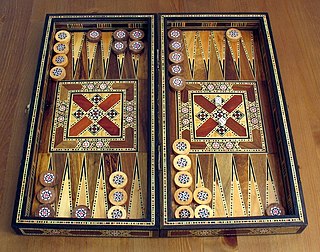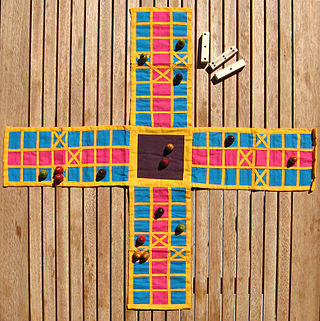
Ludo is a strategy board game for two to four players, in which the players race their four tokens from start to finish according to the rolls of a single die. Like other cross and circle games, Ludo is derived from the Indian game Pachisi. The game and its variations are popular in many countries and under various names.

Tables games are a class of board game that includes backgammon and which are played on a tables board, typically with two rows of 12 vertical markings called points. Players roll dice to determine the movement of pieces. Tables games are among the oldest known board games, and many different varieties are played throughout the world. They are called 'tables' games because the boards consist of four quadrants or 'tables'. The vast majority are race games, the tables board representing a linear race track with start and finish points, the aim being to be first to the finish line, but the characteristic features that distinguish tables games from other race games are that they are two-player games using a large number of pieces, usually fifteen per player.

Pachisi is a cross and circle board game that originated in Ancient India. It is described in the ancient text Mahabharata under the name of "Pasha". It is played on a board shaped like a symmetrical cross. A player's pieces move around the board based upon a throw of six or seven cowrie shells, with the number of shells resting with the aperture upward indicating the number of spaces to move.

Parqués is the Colombian version of a board game in the cross and circle family. The game is described as a "random thinking" game: the moves depend on the roll of the dice but players must consider possible strategies before executing their move. The objective of the game is to advance all the pieces to the end. Once in the safety zone player can use 2 dice until they are one space away from home, where they will then just use one die.

Yut Nori, also known as Yunnori, Nyout, and Yoot, is a traditional board game played in Korea, especially during Korean New Year. The game is also called cheok-sa or sa-hee. The combining-form -nori means 'game'.

The Royal Game of Ur is a two-player strategy race board game of the tables family that was first played in ancient Mesopotamia during the early third millennium BC. The game was popular across the Middle East among people of all social strata and boards for playing it have been found at locations as far away from Mesopotamia as Crete and Sri Lanka. It closely resembles another ancient game called the Game of Twenty Squares or Game of Twenty.

Chaturaji is a four-player chess-like game. It was first described in detail c. 1030 by Al-Biruni in his book India. Originally, this was a game of chance: the pieces to be moved were decided by rolling two dice. A diceless variant of the game was still played in India at the close of the 19th century.

Long dice are dice, often roughly right prisms or antiprisms, designed to land on any of several marked lateral faces, but neither end. Landing on end may be rendered very rare simply by their small size relative to the faces, by the instability implicit in the height of the dice, and by rolling the long dice along their axes rather than tossing. Many long dice provide further insurance against landing on end by giving the ends a rounded or peaked shape, rendering such an outcome physically impossible.

Bul is a running-fight board game originating in Mesoamerica, and is known particularly among several of the Maya peoples of Belize and the Guatemalan highlands. It is uncertain whether this game dates back to the pre-Columbian Maya civilization, or whether it developed in the post-colonial era after the arrival of the Spanish conquistadores.

Running-fight games are board games that essentially combine the method of race games and the goal of elimination-based games such as chess or draughts. Like race games, pieces are moved along linear tracks based on the fall of dice or other lots; but like chess, the object is to capture opponent pieces.
Race game is a large category of board games, in which the object is to be the first to move all one's pieces to the end of a track. This is both the earliest type of board game known, with implements and representations dating back to at least the 3rd millennium BC in Egypt, Iraq, and Iran; and also the most widely dispersed: "all cultures that have games at all have race games". Race games often use dice to decide game options and how far to move pieces.

Awithlaknakwe is a strategy board game from the Zuni Native American Indians of the American Southwest. The board contains 168 squares with diagonal grids. Two or four may play, with players identified as North, West, South, and East.
Catch the Hare is a two-player abstract strategy board game from Europe, and perhaps specifically from Spain. It is a hunt game, and since it uses a standard Alquerque board from the game Alquerque de Doze, it is specifically a tiger hunt game. In some variants, some or all of the diagonal lines are missing which makes it difficult to classify as a tiger game in general. One hare is going up against ten to twelve opponents(hunters or hounds). The hare is the "tiger" in this hunt game which is prey and predator at the same time. The hare can capture the opponents by leaping over them. The opponents attempt to surround and trap the hare.
Robert Charles Bell (1917–2002) was the author of several books on board games, most importantly Board and Table Games 1 & 2. This work won the Premier Award of the Doctors' Hobbies Exhibition, London. He was instrumental in popularizing traditional games, and is acknowledged as one of 11 "principal sources" in David Parlett's The Oxford History of Board Games.

The history of games dates to the ancient human past. Games are an integral part of all cultures and are one of the oldest forms of human social interaction. Games are formalized expressions of play which allow people to go beyond immediate imagination and direct physical activity. Common features of games include uncertainty of outcome, agreed upon rules, competition, separate place and time, elements of fiction, elements of chance, prescribed goals and personal enjoyment.

Zohn Ahl is a roll-and-move board game played by the Kiowa Indians of North America. It is often cited as a typical representative of many similar Native American games. It is often equated with Tsoñä, also played by the Kiowa.
Edris a jin was a cross and circle game played in Syria and Lebanon. It has been compared to Pachisi.
This glossary of board games explains commonly used terms in board games, in alphabetical order. For a list of board games, see List of board games; for terms specific to chess, see Glossary of chess; for terms specific to chess problems, see Glossary of chess problems.

Astronomical chess or Astrological chess for seven is a game from the book Libro de los Juegos, written under king Alfonso X the Wise in 1283. The game was played on a round board with concentric circles. The sky, zodiac signs and planets are the elements of this chess. The book described the games and problems of playing situations in chess, dice and other board games that formed the basis of modern backgammon.














